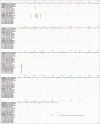Molecular prevalence and associated risk factors of Cryptosporidium spp. infection in dairy cattle in Khon Kaen, Thailand
- PMID: 38595654
- PMCID: PMC11000470
- DOI: 10.14202/vetworld.2024.371-378
Molecular prevalence and associated risk factors of Cryptosporidium spp. infection in dairy cattle in Khon Kaen, Thailand
Abstract
Background and aim: Cryptosporidium spp. are important parasites in the small intestines of humans and animals, particularly cattle. The aim of this study was to estimate the molecular prevalence and associated risk factors of Cryptosporidium infection in dairy cattle in five districts of Khon Kaen province, Thailand, and to identify Cryptosporidium spp.
Materials and methods: From July 2020 to October 2021, 296 fecal samples were collected from three groups of dairy cattle: Calves aged <3 months, calves aged 3 months-1 year, and calves aged >1 year. Cryptosporidium spp. were detected by polymerase chain reaction (PCR) amplifying the 18s RNA gene. Both genus-specific and species-specific primers were used to identify Cryptosporidium confirmed by DNA sequencing. Age, house floor type, and water trough type were evaluated as risk factors. We analyzed all associated risk factor information using the logistic regression test in the Statistical Package for the Social Sciences.
Results: PCR results showed that 40 (13.51%) out of 296 samples were positive for Cryptosporidium spp., including Cryptosporidium bovis (57.50%) and Cryptosporidium ryanae (2.50%). There was a significant association between Cryptosporidium incidence, cattle age, and house floor type (p < 0.05). National Center for Biotechnology Information Basic Local Alignment Search Tool displayed 99.48%-100% nucleotide similarity of each Cryptosporidium spp. isolate with references recorded on GenBank.
Conclusion: C. bovis and C. ryanae are commonly found in dairy cattle, especially calves, in Khon Kaen, Thailand, and the incidence was associated with age and house floor type. A molecular technique may be influential for species identification. The results of the present study would provide useful information for veterinarians and animal owners to understand better Cryptosporidium spp. and how to manage farms properly.
Keywords: Cryptosporidium; bovine cryptosporidiosis; dairy cattle; molecular prevalence.
Copyright: © Keomoungkhoun, et al.
Conflict of interest statement
The authors declare that they have no competing interests.
Figures




Similar articles
-
Prevalence and species identification of Cryptosporidium spp. in the newborn dairy calves from Muang District, Khon Kaen Province, Thailand.Vet World. 2019 Sep;12(9):1454-1459. doi: 10.14202/vetworld.2019.1454-1459. Vet World. 2019. PMID: 31749581 Free PMC article.
-
First report on the molecular prevalence and associated risk factors of Eimeria spp. in dairy cattle in Khon Kaen, Thailand.Vet World. 2023;16(7):1489-1495. doi: 10.14202/vetworld.2023.1489-1495. Epub 2023 Jul 19. Vet World. 2023. PMID: 37621543 Free PMC article.
-
Molecular identification of Cryptosporidium species in Canadian post-weaned calves and adult dairy cattle.Vet Parasitol Reg Stud Reports. 2022 Sep;34:100777. doi: 10.1016/j.vprsr.2022.100777. Epub 2022 Aug 17. Vet Parasitol Reg Stud Reports. 2022. PMID: 36041794
-
Cryptosporidium spp. and Giardia spp. in feces and water and the associated exposure factors on dairy farms.PLoS One. 2017 Apr 12;12(4):e0175311. doi: 10.1371/journal.pone.0175311. eCollection 2017. PLoS One. 2017. PMID: 28403147 Free PMC article.
-
Outbreak of cryptosporidiosis due to Cryptosporidium parvum subtype IIdA19G1 in neonatal calves on a dairy farm in China.Int J Parasitol. 2019 Jun;49(7):569-577. doi: 10.1016/j.ijpara.2019.02.006. Epub 2019 May 7. Int J Parasitol. 2019. PMID: 31071320 Free PMC article.
Cited by
-
Cryptosporidium spp. Infection and Genotype Identification in Pre-Weaned and Post-Weaned Calves in Yunnan Province, China.Animals (Basel). 2024 Jun 27;14(13):1907. doi: 10.3390/ani14131907. Animals (Basel). 2024. PMID: 38998019 Free PMC article.
-
Cryptosporidium in cattle: Assessing the zoonotic risk.Curr Res Parasitol Vector Borne Dis. 2025 Jun 14;8:100279. doi: 10.1016/j.crpvbd.2025.100279. eCollection 2025. Curr Res Parasitol Vector Borne Dis. 2025. PMID: 40656159 Free PMC article.
References
-
- Bowman D.D. Georgis'Parasitology for Veterinarians. 11th ed. Vol. 8. St. Louis, Missouri: Elsevier; 2021. p. 518.
-
- Taylor M.A, Coop R.L, Wall R. Veterinary Parasitology. Chichester, West Sussex, Ames, Iowa: John Wiley and Sons, Inc; 2016. p. 1.
-
- Gao H, Liang G, Su N, Li Q, Wang D, Wang J, Zhao L, Kang X, Guo K. Prevalence and Molecular Characterization of Cryptosporidium spp., Giardia duodenalis, and Enterocytozoon bieneusi in Diarrheic and Non-Diarrheic Calves from Ningxia, Northwestern China. Animals (Basel) 2023;13(12):1983. - PMC - PubMed
LinkOut - more resources
Full Text Sources
Miscellaneous
